Hinduism is a religion, which is termed as the Sanatana Dharma for leading the most upright way of life. It is one of the oldest religion, that originated in the Indian sub-continent and spread its wings across the world due to migration. The goodness or the Sanatana Dharma in the Hindus made it a refined religion. They never showed any kind of violence or unkindness towards the shrewd conquerors and this gave them the strength to fight each battle and come out as winners fighting each attack through every generation. The Hindu religion remained undeterred even in the toughest situations and fought every odds to save and preserve Hinduism, the only existing civilization that survived from the ancient history. Are you aware of the epic wars that saved the Hindu religion from the brutal hands of the dreadful attacks? Now, you must be curious to walk through the glorious past that helped propagate the laws of Dharma, let’s go through-
1- Earliest Hindu Wars – Indra and Vritra
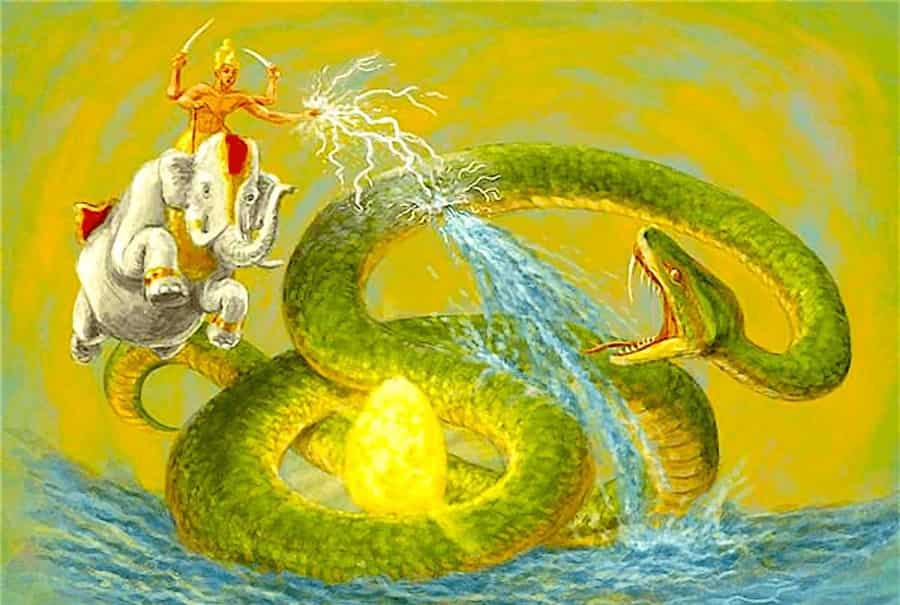
His Command is the ultimate power in Hindu religion. The battle between Lord of Swargalok, Indra, and Lord of Demon, Vritra in the Hindu mythology led to the freedom of cattle, rivers and Ushas when the God of evil, Vritra was defeated by Indra. It was the victory of Hindu God or the triumph of the good over evil.
2- Battle of Ten Kings
There are 5 Rig Vedic clans mentioned in the Vedas- Puru of Dravidian origin, Yadu, Tritsu, Turvasu and Anu of Kolarian origin. The Bharatas, Purus and other Indo- Aryan clans together formed an alliance of 10 kings headed by Puru- Kutsa. This group of 10 Kings confronted the Tritsu King Sudas. The mention of the Dasharadnya Yuddha or the battle of ten kings in the Rig Vedas says that the confederation of 10 kings was defeated by the Tritsu King who was the untainted and chastest of the Brahmanic Aryans. Thus, this war saved the Hinduism and the righteousness of Dharma over Adharma retained.
3- Devas and the Asura
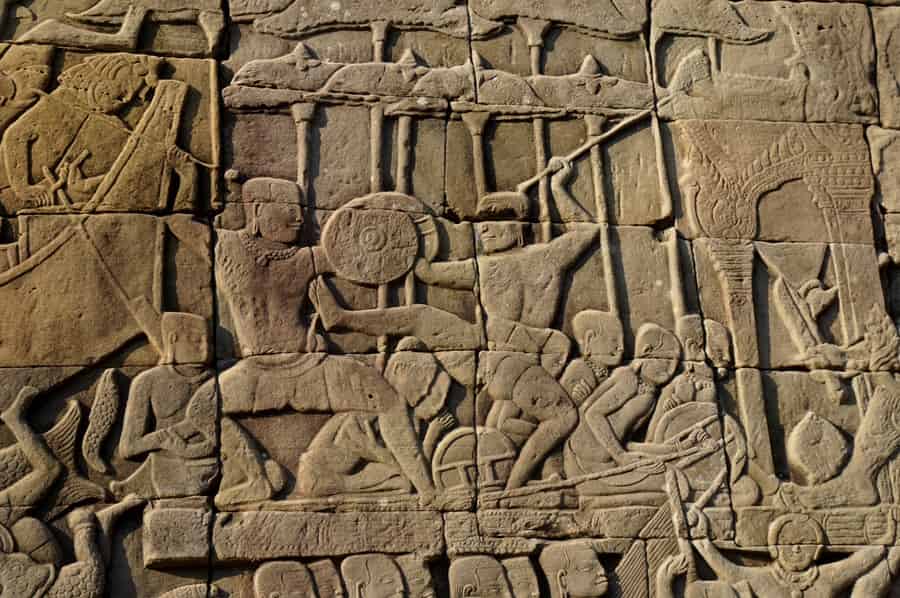
Since age immemorial the good has won over evil. The Hindu mythology has a strong war evidence that has some contribution toward saving the religion. The battle in the Swarg Lok, Bhulok and Paatal Lok between the Devas and the Asuras who had the equal power in religion and martial arts is known to all of you. The Devas who believed in the Good, a Supreme Being and virtue defeated the Asuras, who were agnostic and deceitful in nature and gained power by sacrificing to win the dominion of the 3 worlds.
4- War between Narasimhadeva and Tughan Khan in 1248 CE
When Tugan Khan easily conquered Bengal and attacked Orissa, the then ruler of Orissa Narsimhadeva made his firm decision to use the trick as the Muslim rulers did to conquer various parts of the country. In the thirteenth century, Narsimhadeva sent a word of surrender to the invader and it was accepted. The subterfuge of the Orissa’s ruler worked to their advantage and Tugan Khan was defeated losing all his army. The triumphant King of Orissa raised a success pillar designed as war chariot devoting it to the Sun God Surya and named it Konark. This was an epic war that resulted in saving Hinduism.
5- Battle of Bahraich
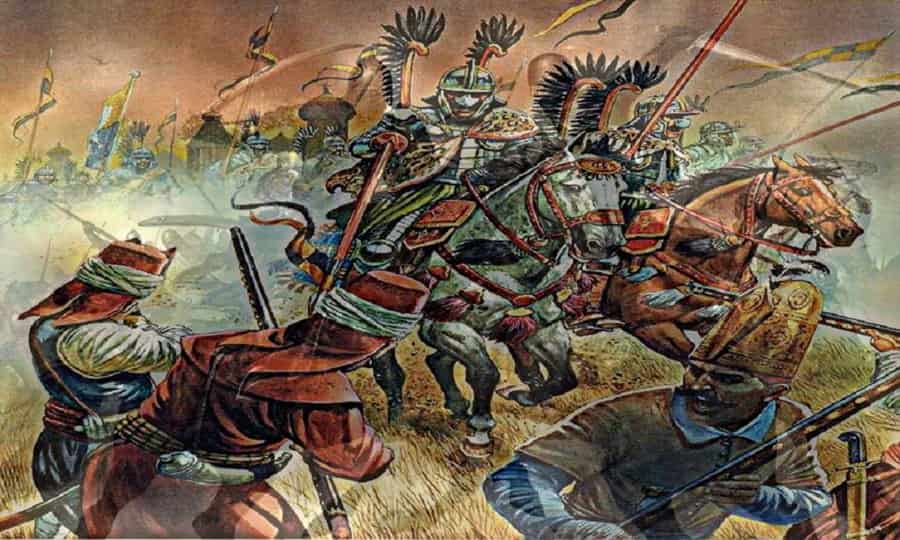
When Mahmud Ghazni’s son, Masud Ghazni, entered deep into Ganges valley and camped in Bahraich, sending a word of surrender to the Hindu kings, he was asked to go back. On refusing, Masud’s army was inundated by a vast Hindu army that resulted in bloodied war. It ended with the entire Muslim army being slaughtered to death and loss of few Hindu martyrs defending the army. A peace for the next 150 years (1033-1187) prevailed saving the Hindu religion and culture.
After some of these glorious Hindu victories, the 27years of the epic war followed to save Hinduism. There were more than 100 wars which almost the entire generation witnessed. This occurrence took place, including a vast area of Modern India, Gujarat, Karnataka, Maharashtra and Madhya Pradesh. The unmatched loss of time, material, life and more has no count in the Indian record.
Establishment and Fall of Deccan Empire
Shivaji’s vigorous efforts bore fruits of success and Deccan was established as a great and powerful Maratha rule. Sahyadris and Konkan were occupied by numerous forts, creating a strong defense wall against the enemies. Shivaji created the base strength, down south with several trade contacts, establishing a strong naval existence. The Deccan Sultanate made a lasting impression with the import of horses and weapons from the Arabian and European traders respectively. Though Shivaji created a strong impact on the Maratha empire and expanded the empire for more than the present state of Maharashtra with firm roots in all regions, his death in the year 1680, led to the weakening of the Deccan Sultanate.
Defeat of Mughal Ruler Aurangzeb
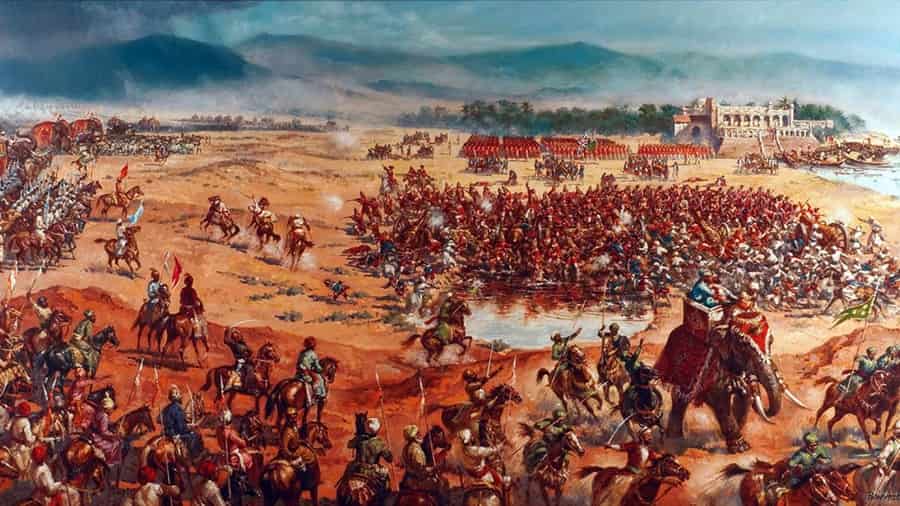
In the North, the weakening of the Rajputs and Southern Sultanate, worked in the Mughal ruler’s favor. The Mughal ruler Aurangzeb ascended the crown, and as the religious extremist, started his prejudiced strategies against the Hindus. Numerous restrictions and taxes were forced on the Hindus, the temples were destroyed and mosques built, Hindus were forced to convert to Islam and many such barbaric activities were imposed on the Hindus. In the year 1681, Aurangzeb moved towards Deccan for destroying the Maratha Empire. Several horses, elephants, soldiers were deployed for the battle. Aurangzeb teamed up with the Portuguese, Golconda, Siddis, Bijapur and British Rulers to form a confirmed trap of death for the Marathas. And the final verdict of the battle was unbelievable, which no one could have ever thought of. If the mass has the will, then surely the way comes through. Even with a much weaker army strength, Maratha empire trampled the desire of the Mughal Emperor to conquer the Deccan Sultanate.
First Phase of the Epic War- Rule of Maratha Ruler Sambhaji
With the death of Shivaji in 1680, Sambhaji took over the reigns of Maratha Sultanate. Aurangzeb, after completing the northern invasions, slowly and steadily started his journey towards Deccan to fulfill his plan of conquering the entire India. In the year 1681, when Sambhaji failed his Janjira attempt and got to know about Aurangzeb’s general, Hussein Ali Khan’s Northern Konkan attack, he pushed him back to Ahmednagar. Aurangzeb was not the one to sit inoperative. He signed an agreement with the Portuguese for the harbor and trade permit of the Mughal ships in Goa. This opened up a sea route to the Deccan. In the year 1682, when Sambhaji came to know about Aurangzeb’s planning, he straightway attacked Portuguese terrain and pushed them in their territory but was defended by Viceroy Alvor. Meanwhile, the Mughal army also gathered on the Deccan borders. This led Sambhaji to leave the Portuguese mission and return.
In the late 1683, Aurangzeb played it safe by dividing his force into two halves- one led by prince Shah Alam who was supposed to attack Konkan and another led by prince Azam Shah who was asked to attack Northern Maratha Region and Khandesh. Full plans and strategies were made and the initial stages went on well. But after entering Goa and while marching towards Konkan, the Marathas harassed and looted Shah Alam, dropping his forces to starve without any supply of food. Rahulla Khan was sent to rescue him and taken back to Ahmednagar. Yha tak checked
In mid-1684, Aurangzeb sent his general to directly attack Raigad, the capital of Maratha but was defeated by the Maratha commanders. In the brutal battle of Patadi, Maratha Commander in Chief defeated Khan Jehan, who was sent to help general Shahabuddin Khan. In Pachad, general Khan was again attacked and Mughal army incurred a heavy loss. In 1685, Shah Alam again attacked Deccan via Dharwar route, but the Maratha army harassed and forced him to leave for the second time. During the year 1685 April, Aurangzeb decided to change strategies and broke treaties with the Golconda and Bijapur empire to attack them. Marathas took this opportunity to attack Bharuch and successfully evaded the Mughal Army.
The year 1686, was a good one for Aurangzeb as he successfully proceeded to the Southern front by occupying Bijapur and Golconda and capturing and imprisoning the Kings of both the territory. In spite of the fall of the two regions, Sambhaji managed to convince the Bijapur Sardars to unite with the Maratha army.
After repeated attacks, finally in the year 1688, Aurangzeb was successful in tricking the Maratha ruler Sambhaji in his sedition. Sambhaji was asked to convert to Islam, but his refusal led him to the worst death that one can ever imagine. He was tied and displayed on a donkey, tongue cut, eyes gorged out and cut into pieces for dog’s feed. This brutal treatment enraged the masses and all peace treaties were withdrawn at once. Rajaram succeeded as the next Maratha Ruler and the second phase of the epic war begun.
Second Phase of the Epic War- Rule of Maratha Ruler Rajaram
After the death of the Maratha Ruler Sambhaji in the year 1688, Aurangzeb made almost a fatal mistake of assuming the end of the Maratha rule by the year 1689. In the year 1690 March, Santaji Ghorpade, headed the Maratha commanders and daringly attacked the Mughal army. It would have been the end of the Aurangzeb rule as his tent was also attacked, but luckily he wasn’t there and thus, saved. Many of his private bodyguards and force were killed in the attack.
Post this attack both positives and negatives followed. Suryaji Pisal treacherously captured Raigad, Yesubai, Sambhaji’s queen and their son was imprisoned. This was followed by Mughal attack on the Panhala fort by Zulfiqar Khan. But he was defeated by the Maratha fort guard and also incurred heavy losses on Mughals. The power of Marathas forced Aurangzeb to come down himself and finally the Panhala gave up.
Maratha army breathed a fresh life when the Maratha capital was shifted to Jinji. For the next 7 years, Jinji became the home for Rajaram. He was guarded by Khando Ballal and his people down South. Bidnur supported them with free supplies and finally Harji Mahadik’s met them near Jinji and guarded them till the fort. The queen was escorted through a separate route by Tungare brothers. Aurangzeb was annoyed with the successful shifting of the Maratha king and queen. Therefore, a special force was sent to keep a check on the King, but his wishes were tarnished by Santaji Ghorpade and Dhanaji Jadhav by defeating the force. The Maratha commanders joined together and met in the Deccan.
In the year 1691, the Maratha Sardars met and revised the strategies in the Maval region. As Zulfikar was again sent to control or keep a check on fort Jinji, the new Maratha plan, explained that Dhanaji and Santaji would commence offensives so that the Mughals remained scattered. Other commanders would keep a check on the Maharashtra region, the forts around Northern Karnataka. The implementation of the strategies began and during the year 1692, Pahala and Raygad were recaptured by the Marathas. Vijaydurg, Rohida, Vishalgad, Kolaba was all captured by the Maratha commanders.
The swift attack by Santaji Ghorpade and Dhanaji Jadhav on Mughal Armies came as a shock for Aurangzeb. He was surprised that how can the Marathas survive and also attack one after the other, in spite the death of one king and another king, being shifted base. Bijapur, Ahmednagar, Khandesh, Konkan, one by one all was captured by Santaji Ghorpade and Dhanaji Jadhav. The success of the plans, one after the other, led them to take a new course of action against the Mughals. Ismail Khan was captured from Kokar and Ali Mardan Khan around the base of Jinjir.
Santaji’s victory against the Mughal commanders continued by defeating, Kasim Khan, Himmat Khan and more. Aurangzeb revised his strategies and got a clear idea that he underestimated the Maratha force. An ultimatum was issued to Zulfiqar Khan to complete the Jinji business or else leave. But Rajaram was again safely escorted by Dhanaji Jadhav, defeating Zulfiqar Khan. A bitter development took place when the Maratha rivalry between Santaji and Dhanaji got worse and Santaji was killed by Dhanaji’ s men. This incidence encouraged the Mughal army and Aurangzeb.
Finally, the Maratha army again built a strong understanding and Rajaram divided it into three segments led by Dhanaji, Shankar Narayan and Parshuram Trimbak. This led to the victory and defeat of Mughal forces. The defeat angered Aurangzeb and he himself took the charge of the army. He tried to capture as many forts in the year 1700.
- Also Read: Battle of Somnath- Symbol of Undying Faith
Third Phase of the Epic War- Rule of Maratha Queen Tarabai
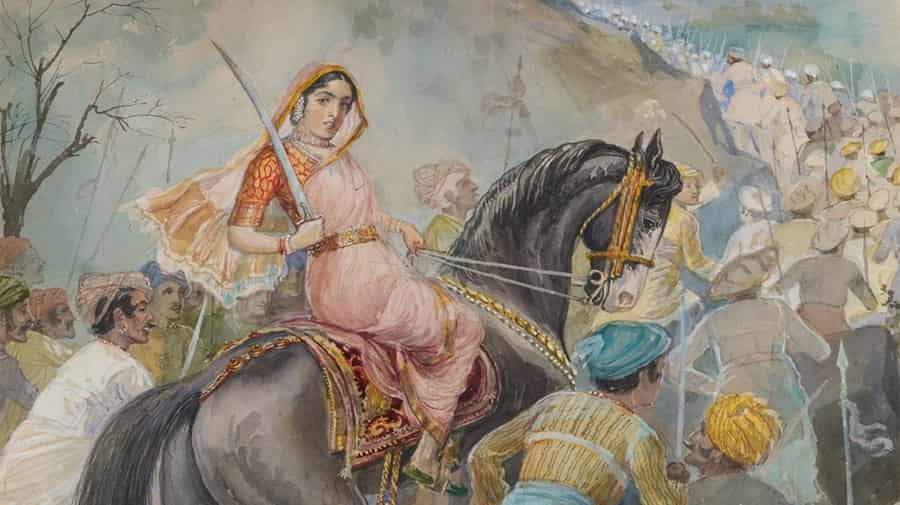
In March 1700, Rajaram took his last breath and his queen Tarabai took the charge of the Maratha Army. She was the daughter of the Maratha army’s brave Commander-in-Chief Hambirrao Mohite. For the next 7 years, Tarabai proved her skills with ease and thus, came the final phase of the Epic war under Tarabai’s rule. In the year 1701 the Mughals showed the signs of misunderstanding, strains and rivalry, weakening the rule to some extent. The 200years Mughal Kingdom was collapsing and knew winning was nearly impossible. They had lost all in the course of trying to destroy the Marathas. Mughals also lost a plenty during the floods on the rivers around. Still Aurangzeb tried to keep the war on.
In 1704, Aurangzeb captured Rajgad and Torna fort and few other small forts. At the end of 24 years, Aurangzeb realized he was far from defeating the Marathas and is nearly where he started. Tarabai fought valiantly in the final attack in the North. The royal treasuries were empty and didn’t have the army to defend and carry on. Maratha nearly captured the entire North.
Aurangzeb tried negotiating with the Marathas but settled on a small kingdom of Wakinara. One by one all forts and provinces was captured by the Maratha commanders and Aurangzeb surrendered all his hopes and planned to move to Burhanpur. Dhanaji Jadhav again attacked him but Zulfiqar Khan managed to rescue the emperor and reach Burhanpur. He witnessed fights and bad relations between his sons. He was sad, bankrupt, lonely, lost and died a sad death on March 3rd, 1707. Thus, the epic war ended saving Hinduism and rising Maratha Empire.
- Also Reads on: Lachit Borphukan: An Unsung Hero of Sanatana Hindu Dharma

 Call
Call WhatsApp
WhatsApp Enquiry
Enquiry